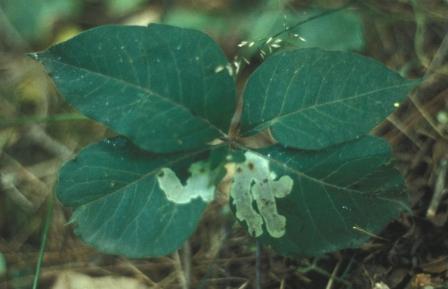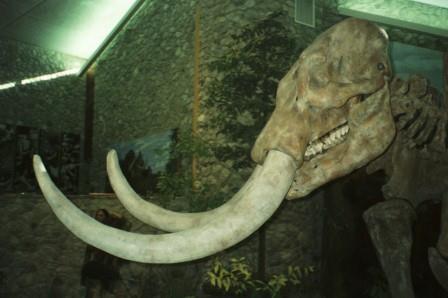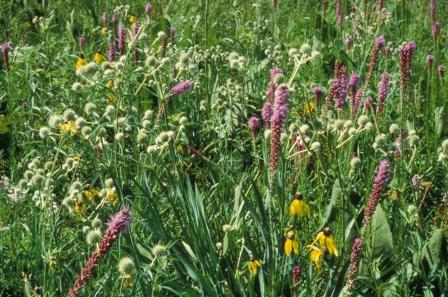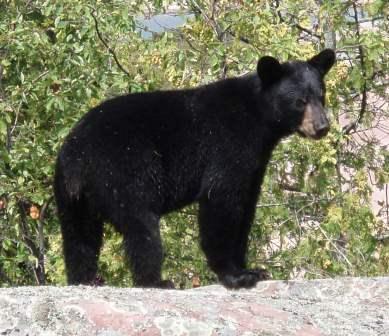by Carl Strang
This year’s winter series is a review of the prehistoric life and geologic history of northeast Illinois. Each chapter will summarize current understanding, gleaned from the literature, of what was going on with life on Earth in a particular span of time, what we know about the local landscape, and what we can say about local life. I include some references, particularly to papers published in the journal Science which commonly is available at public libraries. Contact me if you need sources for other items. The Earth is so old that every imaginable environment was here at some point, from ocean depths to mountaintops, from equatorial tropics to tundra, and from wetlands to desert.

Cenozoic Era, Paleogene Period (65-23.3 million years ago), Paleocene Epoch (65-56.5 mybp)
The Cenozoic Era was named (1841) for the fossil life that characterized it, literally translated “recent life.” Formerly it was divided into two periods, the Tertiary and Quaternary, which no longer are recognized. In recent years it officially has been divided into two different periods, the Paleogene and the Neogene. A proposal under consideration would subdivide the Neogene, reinstating a Quaternary Period that would contain the most recent Pleistocene and Holocene Epochs. The Paleogene Period, established in 1866, defines a time when only a small portion of its fossil species or their very close relatives still are in existence today. It is subdivided into epochs, the first of which is today’s focus. The Paleocene Epoch, first defined in 1874, literally means “ancient recent.” Following Lyell’s original scheme of dividing the Cenozoic Era’s time according to percentage of marine fossil mollusk species still living, the Paleocene has none still living today.
Life on Earth. In New Zealand, researchers have found a heavy layer of fungal spores representing the first few years after the “Chixculub impact” that ended the Mesozoic Era and began the Paleocene (see below). Such abundant fungi performed the decomposition that followed a “wholesale dieback of photosynthetic vegetation” (and this was halfway around the world from the impact site). The fungi were followed by a burst of ferns, a delay then until conifers got going, then a greater delay to the recovered dominance of flowering plants (Science 303:1489). The largest vertebrate to survive the Cretaceous was the freshwater fish-eating reptile Champsosaurus, which survived to the Eocene in North America and Europe.

Imagine a world covered in fungi. That is the image we have of the Earth during the months to years immediately following the impact of the asteroid that marked the beginning of the Paleocene Period. Surviving animals had to be small sized and capable of living on fungi, seeds, or other small animals.
Plant diversity and insect diversity generally were much lower in the Paleocene than in the late Cretaceous, with interesting exceptions that indicate millions of years were needed to re-establish equilibrium in communities of plants and the insects eating them. For instance, in southeastern Montana a high diversity of plant-eating insects occurred on a low-diversity plant community, while another community in Colorado had high plant diversity but low insect diversity (Science 313:1112).
The warmth of the late Paleocene allowed narrow-snouted crocodilians to live in North America and Europe as far north as New Jersey.
The Cenozoic was the time when mammals came to dominate terrestrial animal life on Earth, with the greatest rate of evolution of new families and genera occurring in the early Paleocene. Australia became isolated in the Paleocene, cutting off the flow of marsupials from Antarctica and South America and setting the stage for the most significant marsupial fauna on Earth to evolve from then until recent times. However, North America remained connected to both Asia and Europe through the Paleocene.

Today’s marsupial-dominated Australian fauna, including this wombat, continue a legacy established in the Paleocene.
Paleocene mammals included the multituberculates, a primitive group now extinct, that had been the dominant Cretaceous mammal group. They reached their diversity peak in the Paleocene.
Early carnivore-like mammals, the creodonts (now extinct), appeared in the Paleocene of North America and Europe (with the departure of the dinosaurs, there was an open niche for predators of terrestrial vertebrates as the Paleocene began). True carnivores also emerged in the Paleocene, but the Carnivora of the Paleocene and early Eocene were relatively small and generalized predators, comparable to martens. Thus the creodonts were the significant predatory mammals of these times, rising to prominence in the late Paleocene.
Another important Paleocene mammal group were the condylarths, a somewhat artificial order that gave rise to the ungulates and whales. The earliest condylarths were rat-sized, but they diversified and ultimately included enormous species. Most were generalized in diet, though some tended more toward herbivory and others were more carnivorous.
Treeshrews arose in the early Paleocene (Science 318:792). In the late Paleocene, new groups that appeared were order Perissodactyla (including horses in North America), bats (early bats were flying before they developed the echolocation ability: Science 318:1237), Edentata (in S. America), and rodents (in N. America). Unusually well preserved skulls of a species in the extinct family Apatemyidae reported in 2010 tie the primates to the rodents, treeshrews and flying lemurs.

Fossil bird, Field Museum collection. Modern birds came into their own in the Paleocene.
Out of the great diversity of early bird groups, only one (Neornithes, the modern birds) survived past the end of the Cretaceous. The modern orders of birds diverged during the Paleocene.
Local landscape. Our area may have been directly affected by the meteorite that struck the Yucatan area to end the Mesozoic era. There is evidence that the meteorite came in at a shallow angle from the south, and so scattered debris into North America. Our continent’s forests were flattened except in the far north and in refugia where mountains provided protection from the blast. A tsunami would have been funneled straight into the mid-American sea, and conceivably could have reached Illinois. After the time when photosynthetic vegetation was largely or entirely killed off, as mentioned above, much of the continent may have been “little more than a field of ferns” for up to thousands of years (Science 294: 1668-9) as surviving spores and seeds in the soil re-established terrestrial vegetation. Incidentally, astronomers are 90% certain that the source of the Cretaceous-ending meteorite was a collision between asteroids beyond Mars nearly 100 million years earlier (Science 317:1310).
Our area remained dry land throughout the Cenozoic, though the sea touched the southern tip of Illinois in the Paleocene and Eocene (leaving the nearest deposits for those epochs to here). The climate was warm, moist and tropical with little seasonality in the Paleocene. Tropical forests developed here after the recovery from the meteorite damage.
Local life. At our latitude in the Paleocene there were diverse ferns, ginkgoes, araucarias, palms, members of the walnut and birch families, dogwoods, chestnuts, oaks, sycamores, hackberries, elms, spicebush, sassafras, magnolias, and members of the grape family. Our forest would have been tropical, and evergreen or seasonally deciduous at different points in the Paleocene.
Later in the Paleocene, creodonts were likely here. The first large local mammalian predator was likely a cat-like creodont in the genus Oxyaena. Other creodonts showed adaptations for scavenging. Hyaenodontids were creodonts adapted for running, like dogs or hyenas.
There was an early North American group of primitive mammals, the Taeniodonta, resembling ground sloths but not related to them, that lasted from the early Paleocene to the late Eocene (widely distributed, but always rare; the genus Ectoganus probably was represented locally by a species in the 100-200-pound range).
Most known species of the diverse “order” of condylarths were North American. They were mainly omnivorous, though the most primitive one, Protoungulatum from the early Paleocene of North America and Europe, was more of a specialized predator. The majority, however, were ecologically more like raccoons or bears. Others were more on the vegetarian end of the scale, like pigs and peccaries. The widespread, sheep-sized Phenacodus, late Paleocene to middle Eocene, and its relatives are a good candidate as the ancestors of the Perissodactyla (odd-toed ungulates such as horses). Ungulates in the order Mesonychia tended to predatory habits, and among them were the largest mammals of the early Paleocene (10x the usual rat size). Later, still larger members of this group shared predatory dominance with the creodonts. Coyote-sized Dissacus occurred all over the northern hemisphere.
In the late Paleocene and early Eocene our area may have had a species of Coryphodon, a genus ranging through Europe, Asia and North America, possibly a swamp dweller with a generalist diet. These were members of the Paleocene-Eocene order Pantodonta, among the earliest post-Cretaceous mammals to attain large size. Species ranged from tapir- to ox-sized.
Multituberculates were important in nearly all Paleocene faunas in North America. They ranged from small mouse to beaver in size. An example is Ptilodus, a squirrel-like tree-dweller that probably was an omnivore (I think here of the scrat, the acorn-obsessed critter in the Ice Age animated films). Another North American multituberculate, Taeniolabis, was beaver sized and (unusual for the time) a specialized herbivore.
Early arboreal mammals in North America were primates or primate relatives similar to today’s treeshrews. A late-Paleocene genus, Plesiadapis, occurred in both North America and Europe. Another family culminated in the genus Carpolestes, possessing the only fingernails (as opposed to claws) known outside the true primates. Two families were lemur-like.
The fish-eating Champsosaurus, mentioned above, may have inhabited local rivers. There would have been a variety of birds, locally, too.









